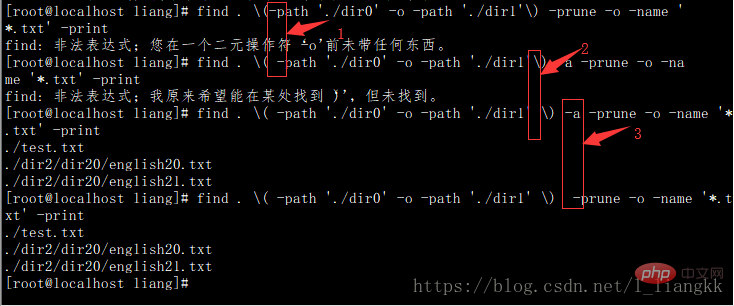linux find指令怎麼用
在linux中,find指令用於在指定目錄下尋找文件,基本語法「find path -option..」。任何位於參數之前的字串都將被視為欲查找的目錄名;如果使用該命令時,不設定任何參數,則find命令將在當前目錄下查找子目錄與檔案。

本教學操作環境:Red Hat Enterprise Linux 6.1系統、Dell G3電腦。
Linux find 指令用來在指定目錄下尋找檔案.
find指令格式:
find path -option 【 -print 】 【 -exec -ok |xargs |grep 】 【 command {} \; 】find指令的參數:
1)path:要尋找的目錄路徑。
- ~ 表示$HOME目錄
- . 表示當前目錄
- / 表示根目錄
2 )print:表示將結果輸出到標準輸出。
3)exec:對符合的檔案執行此參數所給的shell指令。
形式為command {} \;,注意{}與\;之間有空格
4)ok:與exec作用相同,
差異在於,在執行指令之前,都會給予提示,讓使用者確認是否執行
5)|xargs 與exec作用相同,起承接作用
差異在於 |xargs 主要用於承接刪除操作,而 -exec 都可用如複製、移動、重新命名等
6)options :表示查找方式
options常用的有下選項:
-name filename #查找名为filename的文件 -perm #按执行权限来查找 -user username #按文件属主来查找 -group groupname #按组来查找 -mtime -n +n #按文件 更改时间 来查找文件,-n指n天以内,+n指n天以前 -atime -n +n #按文件 访问时间 来查找文件,-n指n天以内,+n指n天以前 -ctime -n +n #按文件 创建时间 来查找文件,-n指n天以内,+n指n天以前 -nogroup #查无有效属组的文件,即文件的属组在/etc/groups中不存在 -nouser #查无有效属主的文件,即文件的属主在/etc/passwd中不存 -type b/d/c/p/l/f #查是块设备、目录、字符设备、管道、符号链接、普通文件 -size n[c] #查长度为n块[或n字节]的文件 -mount #查文件时不跨越文件系统mount点 -follow #如果遇到符号链接文件,就跟踪链接所指的文件 -prune #忽略某个目录
任何位於參數之前的字串都會被視為欲查找的目錄名稱。如果使用該指令時,不設定任何參數,則 find 指令將在目前目錄下尋找子目錄與檔案。並且將查找到的子目錄和檔案全部進行顯示。
下面透過一些簡單的例子來介紹下find的常規用法:
1、按名字查找
在目前目錄及子目錄中,找出大寫字母開頭的txt檔案
$ find . -name '[A-Z]*.txt' -print
在/etc及其子目錄中,找出host開頭的檔案
$ find /etc -name 'host*' -print
在$HOME目錄及其子目錄中,尋找所有檔案
$ find ~ -name '*' -print
在目前目錄及子目錄中,找出不是out開頭的txt檔案
$ find . -name "out*" -prune -o -name "*.txt" -print
2、按目錄查找
在目前目錄除aa以外的子目錄內搜尋txt檔案
$ find . -path "./aa" -prune -o -name "*.txt" -print
# 在目前目錄及除aa和bb之外的子目錄中尋找txt檔案
$ find . \( -path './dir0' -o -path './dir1' \) -a -prune -o -name '*.txt' -print

注意:在1、2處都需要加空格,否則會出現如圖所示的錯誤
在3處加不加-a都可以
在目前目錄,不再子目錄中,查找txt文件
$ find . ! -name "." -type d -prune -o -type f -name "*.txt" -print
或者
find . -name *.txt -type f -print
友情鏈接:Linux中find命令-path -prune用法詳解
3、依權限查找
在目前目錄及子目錄中,尋找屬主具有讀寫執行,其他具有讀取執行權限的檔案
$find . -perm 755 -print
尋找使用者有寫權限或群組使用者有寫權限的檔案或目錄
find ./ -perm /220 find ./ -perm /u+w,g+w find ./ -perm /u=w,g=w
4、按類型尋找(b/d/c/p/l/f )
在目前目錄及子目錄下,查找符號連結檔案
$ find . -type l -print
5、按屬主及屬組
尋找屬主是www的檔案
$ find / -user www -type f -print
尋找屬主被刪除的文件
$ find / -nouser -type f -print
查找屬組mysql 的文件
$ find / -group mysql -type f -print
查找用戶組被刪掉的文件
$ find / -nogroup -type f -print
6、按時間查找
查找2天內被更改過的檔案
$ find . -mtime -2 -type f -print
尋找2天前被更改過的檔案
$ find . -mtime +2 -type f -print
尋找一天前被存取的文件 ##
$ find . -atime -1 -type f -print
#
$ find . -atime +1 -type f -print
$ find . -ctime -1 -type f -print
$ find . -ctime +1 -type f -print
$ find . -cmin +10 -type f -print
尋找一天內狀態已變更的檔案」與查找一天前狀態被改變的文件
$ find . -ctime +1 -type f -print
查找10分钟以前状态被改变的文件
$ find . -cmin +10 -type f -print
7、按文件新旧
查找比 aa.txt 新的文件
$ find . -newer "aa.txt" -type f -print
查找比 aa.txt 旧的文件
$ find . ! -newer "aa.txt" -type f -print
查找比aa.txt新,比bb.txt旧的文件
$ find . -newer 'aa.txt' ! -newer 'bb.txt' -type f -print
8、按大小查找
查找超过1M的文件
$ find / -size +1M -type f -print
查找等于6字节的文件
$ find . -size 6c -print
查找小于32k的文件
$ find . -size -32k -print
9、执行命令
1)查找 del.txt 并删除,删除前提示确认
$ find . -name 'del.txt' -ok rm {} \; 2) 查找 aa.txt 并备份为aa.txt.bak
$ find . -name 'aa.txt' -exec cp {} {}.bak \;3)查当前目录下的所有普通文件
# find . -type f -exec ls -l {} \;
-rw-r–r– 1 root root 34928 2003-02-25 ./conf/httpd.conf
-rw-r–r– 1 root root 12959 2003-02-25 ./conf/magic
-rw-r–r– 1 root root 180 2003-02-25 ./conf.d/README查当前目录下的所有普通文件,并在 - exec 选项中使用 ls -l 命令将它们列出
4)在 /logs 目录中查找更改时间在5日以前的文件并删除它们
$ find logs -type f -mtime +5 -exec -ok rm {} \;5)查询当天修改过的文件
# find ./ -mtime -1 -type f -exec ls -l {} \;6)查询文件并询问是否要显示
# find ./ -mtime -1 -type f -ok ls -l {} \;
< ls … ./classDB.inc.php > ? y
-rw-r–r– 1 cnscn cnscn 13709 1月 12 12:22 ./classDB.inc.php
# find ./ -mtime -1 -type f -ok ls -l {} \;
< ls … ./classDB.inc.php > ? n关于 有没有 -print 的区别
加 -print
查找目录并列出目录下的文件(为找到的每一个目录单独执行ls命令,没有选项-print时文件列表前一行不会显示目录名称)
find /home -type d -print -exec ls {} \;
不加 -print

相关推荐:《Linux视频教程》
以上是linux find指令怎麼用的詳細內容。更多資訊請關注PHP中文網其他相關文章!

熱AI工具

Undresser.AI Undress
人工智慧驅動的應用程序,用於創建逼真的裸體照片

AI Clothes Remover
用於從照片中去除衣服的線上人工智慧工具。

Undress AI Tool
免費脫衣圖片

Clothoff.io
AI脫衣器

Video Face Swap
使用我們完全免費的人工智慧換臉工具,輕鬆在任何影片中換臉!

熱門文章

熱工具

記事本++7.3.1
好用且免費的程式碼編輯器

SublimeText3漢化版
中文版,非常好用

禪工作室 13.0.1
強大的PHP整合開發環境

Dreamweaver CS6
視覺化網頁開發工具

SublimeText3 Mac版
神級程式碼編輯軟體(SublimeText3)
 Linux體系結構:揭示5個基本組件
Apr 20, 2025 am 12:04 AM
Linux體系結構:揭示5個基本組件
Apr 20, 2025 am 12:04 AM
Linux系統的五個基本組件是:1.內核,2.系統庫,3.系統實用程序,4.圖形用戶界面,5.應用程序。內核管理硬件資源,系統庫提供預編譯函數,系統實用程序用於系統管理,GUI提供可視化交互,應用程序利用這些組件實現功能。
 vscode上一步下一步快捷鍵
Apr 15, 2025 pm 10:51 PM
vscode上一步下一步快捷鍵
Apr 15, 2025 pm 10:51 PM
VS Code 一步/下一步快捷鍵的使用方法:一步(向後):Windows/Linux:Ctrl ←;macOS:Cmd ←下一步(向前):Windows/Linux:Ctrl →;macOS:Cmd →
 git怎麼查看倉庫地址
Apr 17, 2025 pm 01:54 PM
git怎麼查看倉庫地址
Apr 17, 2025 pm 01:54 PM
要查看 Git 倉庫地址,請執行以下步驟:1. 打開命令行並導航到倉庫目錄;2. 運行 "git remote -v" 命令;3. 查看輸出中的倉庫名稱及其相應的地址。
 notepad怎麼運行java代碼
Apr 16, 2025 pm 07:39 PM
notepad怎麼運行java代碼
Apr 16, 2025 pm 07:39 PM
雖然 Notepad 無法直接運行 Java 代碼,但可以通過借助其他工具實現:使用命令行編譯器 (javac) 編譯代碼,生成字節碼文件 (filename.class)。使用 Java 解釋器 (java) 解釋字節碼,執行代碼並輸出結果。
 sublime寫好代碼後如何運行
Apr 16, 2025 am 08:51 AM
sublime寫好代碼後如何運行
Apr 16, 2025 am 08:51 AM
在 Sublime 中運行代碼的方法有六種:通過熱鍵、菜單、構建系統、命令行、設置默認構建系統和自定義構建命令,並可通過右鍵單擊項目/文件運行單個文件/項目,構建系統可用性取決於 Sublime Text 的安裝情況。
 Linux的主要目的是什麼?
Apr 16, 2025 am 12:19 AM
Linux的主要目的是什麼?
Apr 16, 2025 am 12:19 AM
Linux的主要用途包括:1.服務器操作系統,2.嵌入式系統,3.桌面操作系統,4.開發和測試環境。 Linux在這些領域表現出色,提供了穩定性、安全性和高效的開發工具。
 laravel安裝代碼
Apr 18, 2025 pm 12:30 PM
laravel安裝代碼
Apr 18, 2025 pm 12:30 PM
要安裝 Laravel,需依序進行以下步驟:安裝 Composer(適用於 macOS/Linux 和 Windows)安裝 Laravel 安裝器創建新項目啟動服務訪問應用程序(網址:http://127.0.0.1:8000)設置數據庫連接(如果需要)







